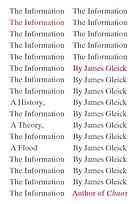History of Information Science
People have been interested in information as a means of communication for a long time.
Read these two chapters and be ready to discuss them in class

Gleick, J. (2011).
The information: A history, a theory, a flood.
New York, NY: Pantheon Books.
-
read chapter chapter 5, A nervous system for the Earth. As you read it, think about:
⇒ the concept of creating meaning from nothing more than the position of a switch (p. 143)
⇒ the concept of a common sense of time (p. 148)
⇒ the concept of a common sense of encoding (p. 152) -
read chapter chapter 6, New wires, new logic. As you read it, think about:
⇒ Vannevar Bush's comment about the value not of being able to manipulate figures, but rather to be skilled in the use of symbolic logic (p. 172)
⇒ the idea that language is just the symbolic coding of meaning (pp. 177-178)
⇒ the concept that numbers may be used to encode all reasoning (p. 185)
If the item on the Napoleonic semaphore in chapter 5 piqued your interest ...

Look at the video that precedes Hugh Schofield 16 June 2013 article on BBC news, How Napoleon's semaphore telegraph changed the world.
[top]


